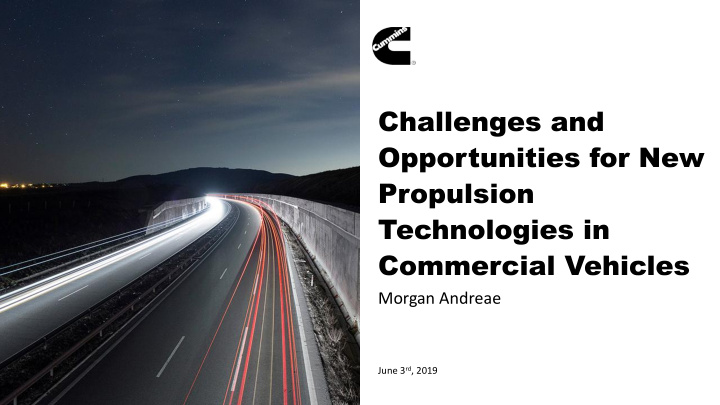



Challenges and Opportunities for New Propulsion Technologies in Commercial Vehicles Morgan Andreae June 3 rd , 2019
Technology Disruptions • New technologies periodically improve the movement of freight and people • Usually these disruptions result from a combination of multiple innovations SS California 1848 1850’s locomotive 1917 Model T ? 1931 diesel truck
3 Major Drivers of Change Regulations Technology Energy Prices • Subsidies towards greener • Technological • Energy prices based on technologies breakthroughs overcoming countries’ locally-produced technical barriers natural resources • Greater willingness to invest in infrastructure • Increased scale in • New approaches to disruptive technologies resources extraction • Impact on energy prices reflected in much lower through carbon taxes • Changing demand patterns costs • Fossil fuel bans • Accelerated infrastructure pacing via private sector investments
Key Drivers for Commercial Vehicle Propulsion Technology Choices Total Cost of Dependability Ownership Reliability Initial Cost Durability Fluid Economy Maintenance Emissions Sociability
Commercial Vehicles and New Propulsion Technologies Significant Challenges to Great Opportunity for Adoption of New Application of New Technology Technology Uptime is critical High Energy Use Durability requirements Often predictable routes are demanding Sometimes controlled Specialized requirements environment and low volumes LH truck: 1 day downtime ~ $1000 • LH truck ~ 250MWhr/yr (50x pass car) • 10% of LH trucks run 250k mi/yr • • Bus & delivery trucks often have fixed City buses often operate 16-20 hr/day • routes City bus: 5000 new veh/yr in North America • Forklift and drayage trucks operate in • controlled environments
Technology Requirements for Commercial Vehicles Electric powertrain Diesel technology technology Refuel time Energy Storage Energy Storage Refuel time Life 1+ hr 400-800 kWhr (battery) 1.6 MWh 1M miles 15 min (@350kW refuel time (100 gal @ 40k hrs (~5MW increases by ~14x) 40% eff) usable energy transfer) 5-10 min 40k hrs 0.8 MWh @350kW refuel (~5MW usable 400 kWhr (battery) time energy transfer) increases by ~14x Energy transfer for electric commercial vehicles remains a challenge. For a fleet, the challenge is significant.
T H E E L E C T R I C I T Y I S C O M I N G
2 0 - 2 5 Y E A R S O F T R A N S I T I O N
Phase 1 Sociability need Capability to use current technology Suitable drive cycle Subsidies High density urban cities Emissions containment areas Industrial policy driven cities
Phase 2 Improved technology Wider local regulations Some subsidies Broader charging infrastructure High density urban cities ULE Zones in US/Western EU
Phase 3 Viable economics Further technology breakthroughs Leapfrogging diesel emissions Traditional commercial vehicles
Powertrain of now D I E S E L N AT U R A L G A S HD Long Haul HD Regional Haul Delivers coast to coast Dedicated route; 200-300 miles/day 500-600 miles/day –––––––––––––––––– Empty interstates Access to economically-priced Steady cruise speeds natural gas; Incentivized ––––––––––––––––– Refuse Truck Unreliable access Access to making the fuel cheap to natural gas Air quality issues in service area H Y B R I D F U L LY E L E C T R I C Utility Truck Urban Transit Bus Makes repairs at regional/ Densely populated area local sites Air/noise quality issues ––––––––––––––––– –––––––––––––––––––– During repair work, Electricity readily available vehicle-to-grid power in route & at depot electronics provides power –––––––––––––––––––– through battery/ engine to Lowers operation costs; Capital cost keep neighborhood in power borne by FTA grant process
Powertrain of the future? Electric power plays an F U E L C E L L increasingly important Diversity of application High Energy Requirements specific solutions role, but pace of 200-300+ miles/day adoption is uncertain –––––––––––––––––– F U L LY E L E C T R I C Fast refuel, better energy storage capacity Low Energy Requirements Densely populated area Air/noise quality issues –––––––––––––––––––– Pure electric solutions Electricity readily available A U TO N O M O U S in route & at depot for applications with Where driver costs high Autonomous changes lower energy missions and business Hard to predict pace requirements, fuel cell models –––––––––––––––––––– for higher energy May impact vehicle design applications and powertrain design
Q+A
Recommend
More recommend